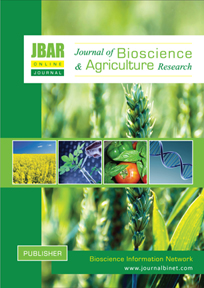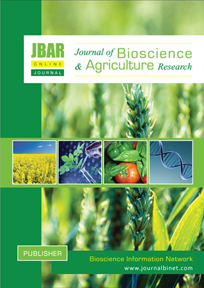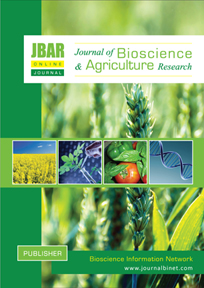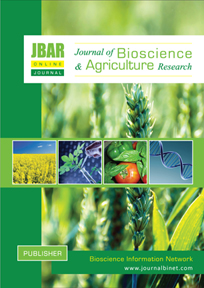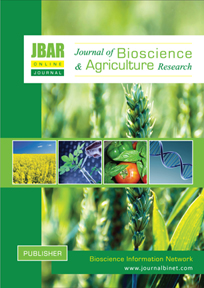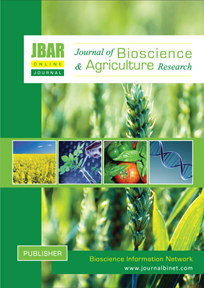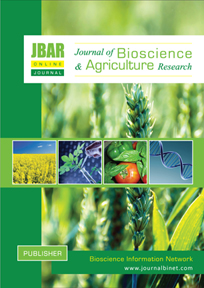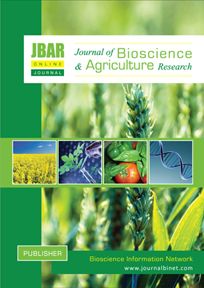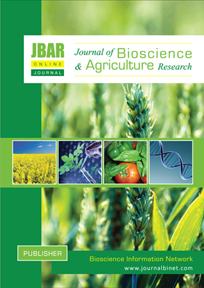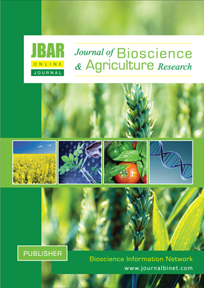Journal of Bioscience and Agriculture Research
Volume 28 - Issue 01 | Year of Publication: 2021
Article Type: Research Article | No. 281, 2021 | Country: Bangladesh | pp. 2315-2323 | Open Access
Title: Morphological analysis, vegetative growth and yield performance of fifteen sweet potato germplasm
Authors: Muntaha, S., Raisa, I., Dina, A., Rakibuzzaman, M. and Uddin, A. F. M. J.
DOI: https://doi.org/10.18801/jbar.280121.281
Title: Morphological analysis, vegetative growth and yield performance of fifteen sweet potato germplasm
Authors: Muntaha, S., Raisa, I., Dina, A., Rakibuzzaman, M. and Uddin, A. F. M. J.
DOI: https://doi.org/10.18801/jbar.280121.281
Morphological analysis, vegetative growth and yield performance of fifteen sweet potato germplasm
Abstract
A field experiment was performed to the study morphological analysis, growth and yield of fifteen sweet potato germplasm at the Horticulture Farm, Sher-e-Bangla Agricultural University, Bangladesh, during September 2018 to March 2019 following Randomized Complete Block Design (RCBD) with three replications. Fifteen sweet potato germplasm were collected from different countries based on skin and flesh colors of root tuber were used in this experiment. Based on the directions of the Union for the Protection of Plant Varieties (UPOV), they were classified according to their morphological differences. Different vegetative growth, reproductive growth and yield contributing parameters were studied and different germplasm showed different results from each other. Among them, maximum number of tuberous roots/plants (7.3) was observed from G4. On the other, the utmost weight of a single root tuber (157.4 g), tuberous root yield/plant (1091.0 g) and tuberous root yield/ha (60.6 t/ha) were observed in G7. In addition, statistically identical results were found in tuberous root yield/ha in G3 (59.1 t/ha). The germplasm G1, G2, G3, G4, G5, G6, G7, G9, G12 and G14 can be utilized to have potential due to higher yield compared to our local variety. Furthermore, yield with color observation G11 may also have the prospects. This study would be effective for further research for researchers and breeders to adapt and recommend them in our country to pomp the agriculture sector.
Key Words: Sweet potato, Morpho-physiology, Germplasm and UPOV.
Abstract
A field experiment was performed to the study morphological analysis, growth and yield of fifteen sweet potato germplasm at the Horticulture Farm, Sher-e-Bangla Agricultural University, Bangladesh, during September 2018 to March 2019 following Randomized Complete Block Design (RCBD) with three replications. Fifteen sweet potato germplasm were collected from different countries based on skin and flesh colors of root tuber were used in this experiment. Based on the directions of the Union for the Protection of Plant Varieties (UPOV), they were classified according to their morphological differences. Different vegetative growth, reproductive growth and yield contributing parameters were studied and different germplasm showed different results from each other. Among them, maximum number of tuberous roots/plants (7.3) was observed from G4. On the other, the utmost weight of a single root tuber (157.4 g), tuberous root yield/plant (1091.0 g) and tuberous root yield/ha (60.6 t/ha) were observed in G7. In addition, statistically identical results were found in tuberous root yield/ha in G3 (59.1 t/ha). The germplasm G1, G2, G3, G4, G5, G6, G7, G9, G12 and G14 can be utilized to have potential due to higher yield compared to our local variety. Furthermore, yield with color observation G11 may also have the prospects. This study would be effective for further research for researchers and breeders to adapt and recommend them in our country to pomp the agriculture sector.
Key Words: Sweet potato, Morpho-physiology, Germplasm and UPOV.
HOW TO CITE THIS ARTICLE?
MLA
Muntaha, S. et al. “Morphological analysis, vegetative growth and yield performance of fifteen sweet potato germplasm”. Journal of Bioscience and Agriculture Research, 28(01), (2021): 2315-2323.
APA
Muntaha, S., Raisa, I., Dina, A., Rakibuzzaman, M. and Uddin, A. F. M. J. (2021). Morphological analysis, vegetative growth and yield performance of fifteen sweet potato germplasm. Journal of Bioscience and Agriculture Research, 28(01), 2315-2323.
Chicago
Muntaha, S., Raisa, I., Dina, A., Rakibuzzaman, M. and Uddin, A. F. M. J. “Morphological analysis, vegetative growth and yield performance of fifteen sweet potato germplasm”. Journal of Bioscience and Agriculture Research, 28(01), (2021): 2315-2323.
Harvard
Muntaha, S., Raisa, I., Dina, A., Rakibuzzaman, M. and Uddin, A. F. M. J. 2021. Morphological analysis, vegetative growth and yield performance of fifteen sweet potato germplasm. Journal of Bioscience and Agriculture Research, 28(01), pp. 2315-2323.
Vancouver
Muntaha, S, Raisa, I, Dina, A, Rakibuzzaman, M and Uddin, AFMJ. Morphological analysis, vegetative growth and yield performance of fifteen sweet potato germplasm. Journal of Bioscience and Agriculture Research, 2021 August, 28(01): 2315-2323.
MLA
Muntaha, S. et al. “Morphological analysis, vegetative growth and yield performance of fifteen sweet potato germplasm”. Journal of Bioscience and Agriculture Research, 28(01), (2021): 2315-2323.
APA
Muntaha, S., Raisa, I., Dina, A., Rakibuzzaman, M. and Uddin, A. F. M. J. (2021). Morphological analysis, vegetative growth and yield performance of fifteen sweet potato germplasm. Journal of Bioscience and Agriculture Research, 28(01), 2315-2323.
Chicago
Muntaha, S., Raisa, I., Dina, A., Rakibuzzaman, M. and Uddin, A. F. M. J. “Morphological analysis, vegetative growth and yield performance of fifteen sweet potato germplasm”. Journal of Bioscience and Agriculture Research, 28(01), (2021): 2315-2323.
Harvard
Muntaha, S., Raisa, I., Dina, A., Rakibuzzaman, M. and Uddin, A. F. M. J. 2021. Morphological analysis, vegetative growth and yield performance of fifteen sweet potato germplasm. Journal of Bioscience and Agriculture Research, 28(01), pp. 2315-2323.
Vancouver
Muntaha, S, Raisa, I, Dina, A, Rakibuzzaman, M and Uddin, AFMJ. Morphological analysis, vegetative growth and yield performance of fifteen sweet potato germplasm. Journal of Bioscience and Agriculture Research, 2021 August, 28(01): 2315-2323.
Article Type: Research Article | No. 282, 2021 | Country: Bangladesh | pp. 2324-2334 | Open Access
Title: Assessing livelihood and socio-economic status of fishermen community adjacent to Chalan beel area in Faridpur upazila, Pabna, Bangladesh
Authors: Rahman, M. M., Motin, M. A., Islam, M. S., Haque, S. A., Islam, M. F. and Rahman, M.
DOI: https://doi.org/10.18801/jbar.280121.282
Title: Assessing livelihood and socio-economic status of fishermen community adjacent to Chalan beel area in Faridpur upazila, Pabna, Bangladesh
Authors: Rahman, M. M., Motin, M. A., Islam, M. S., Haque, S. A., Islam, M. F. and Rahman, M.
DOI: https://doi.org/10.18801/jbar.280121.282
Assessing livelihood and socio-economic status of fishermen community adjacent to Chalan beel area in Faridpur upazila, Pabna, Bangladesh
Abstract
The present study was carried out to update the livelihood and socio-economic conditions of the fishermen community adjacent to the Chalan beel area in Faridpur Upazila of Pabna District in Bangladesh. The data was collected from primary sources (interviews, questionnaire surveys, personal and group discussions) and secondary sources (government and non-government organizations) from July 2020 to December 2020. The fishermen community mainly depends on Chalan beel for self-employment (fishing), income, food and nutrition, as well as sustainable livelihood status, etc. According to the findings, the bulk of the fishermen (40%) were between the ages of 31 and 45, as well as more than two thirds of the respondents (68%) were Muslims and the rest were Hindus. About 70% of responding fishermen were illiterate and 30% were literate. The respondent fishermen also suffered from various common diseases, i.e. gastritis (36%), diarrhoea (24%), fever (23% etc. Here, 5% of fishermen had Kacha houses (made of mud and straw), 70% had tin shed houses, 18% had half-buildings and only 7% of fishermen had buildings (made of concrete). Due to the gradual development of the whole of Bangladesh over time, all of the fishermen got access to electricity facilities and used tube-well water for drinking purposes and mobile phones as modern communication devices. However, because of the increased rate of illiteracy, decreased income level, and climate change (frequent natural disasters such as floods, droughts, cyclones, etc.), their livelihood and social status face a risk of vulnerability throughout the year. Consequently, they lived in poverty and did not meet their demands satisfactorily beyond basic needs from generation to generation. So, government and non-government organizations should take constructive initiatives to boost their livelihoods and socio-economic standing by offering high-quality educational facilities, more financial assistance, rehabilitation and proper infrastructural improvement for road communication in the study area.
Key Words: Sustainable livelihood, Fisher communities and Chalan beel.
Abstract
The present study was carried out to update the livelihood and socio-economic conditions of the fishermen community adjacent to the Chalan beel area in Faridpur Upazila of Pabna District in Bangladesh. The data was collected from primary sources (interviews, questionnaire surveys, personal and group discussions) and secondary sources (government and non-government organizations) from July 2020 to December 2020. The fishermen community mainly depends on Chalan beel for self-employment (fishing), income, food and nutrition, as well as sustainable livelihood status, etc. According to the findings, the bulk of the fishermen (40%) were between the ages of 31 and 45, as well as more than two thirds of the respondents (68%) were Muslims and the rest were Hindus. About 70% of responding fishermen were illiterate and 30% were literate. The respondent fishermen also suffered from various common diseases, i.e. gastritis (36%), diarrhoea (24%), fever (23% etc. Here, 5% of fishermen had Kacha houses (made of mud and straw), 70% had tin shed houses, 18% had half-buildings and only 7% of fishermen had buildings (made of concrete). Due to the gradual development of the whole of Bangladesh over time, all of the fishermen got access to electricity facilities and used tube-well water for drinking purposes and mobile phones as modern communication devices. However, because of the increased rate of illiteracy, decreased income level, and climate change (frequent natural disasters such as floods, droughts, cyclones, etc.), their livelihood and social status face a risk of vulnerability throughout the year. Consequently, they lived in poverty and did not meet their demands satisfactorily beyond basic needs from generation to generation. So, government and non-government organizations should take constructive initiatives to boost their livelihoods and socio-economic standing by offering high-quality educational facilities, more financial assistance, rehabilitation and proper infrastructural improvement for road communication in the study area.
Key Words: Sustainable livelihood, Fisher communities and Chalan beel.
HOW TO CITE THIS ARTICLE?
MLA
Rahman, M. M. et al. “Assessing livelihood and socio-economic status of fishermen community adjacent to Chalan beel area in Faridpur upazila, Pabna, Bangladesh”. Journal of Bioscience and Agriculture Research, 28(01), (2021): 2324-2334.
APA
Rahman, M. M., Motin, M. A., Islam, M. S., Haque, S. A., Islam, M. F. and Rahman, M. (2021). Assessing livelihood and socio-economic status of fishermen community adjacent to Chalan beel area in Faridpur upazila, Pabna, Bangladesh. Journal of Bioscience and Agriculture Research, 28(01), 2324-2334.
Chicago
Rahman, M. M., Motin, M. A., Islam, M. S., Haque, S. A., Islam, M. F. and Rahman, M. “Assessing livelihood and socio-economic status of fishermen community adjacent to Chalan beel area in Faridpur upazila, Pabna, Bangladesh”. Journal of Bioscience and Agriculture Research, 28(01), (2021): 2324-2334.
Harvard
Rahman, M. M., Motin, M. A., Islam, M. S., Haque, S. A., Islam, M. F. and Rahman, M. 2021. Assessing livelihood and socio-economic status of fishermen community adjacent to Chalan beel area in Faridpur upazila, Pabna, Bangladesh. Journal of Bioscience and Agriculture Research, 28(01), pp. 2324-2334.
Vancouver
Rahman, MM, Motin, MA, Islam, MS, Haque, SA, Islam, MF and Rahman, M. Assessing livelihood and socio-economic status of fishermen community adjacent to Chalan beel area in Faridpur upazila, Pabna, Bangladesh. Journal of Bioscience and Agriculture Research, 2021 August, 28(01): 2324-2334.
MLA
Rahman, M. M. et al. “Assessing livelihood and socio-economic status of fishermen community adjacent to Chalan beel area in Faridpur upazila, Pabna, Bangladesh”. Journal of Bioscience and Agriculture Research, 28(01), (2021): 2324-2334.
APA
Rahman, M. M., Motin, M. A., Islam, M. S., Haque, S. A., Islam, M. F. and Rahman, M. (2021). Assessing livelihood and socio-economic status of fishermen community adjacent to Chalan beel area in Faridpur upazila, Pabna, Bangladesh. Journal of Bioscience and Agriculture Research, 28(01), 2324-2334.
Chicago
Rahman, M. M., Motin, M. A., Islam, M. S., Haque, S. A., Islam, M. F. and Rahman, M. “Assessing livelihood and socio-economic status of fishermen community adjacent to Chalan beel area in Faridpur upazila, Pabna, Bangladesh”. Journal of Bioscience and Agriculture Research, 28(01), (2021): 2324-2334.
Harvard
Rahman, M. M., Motin, M. A., Islam, M. S., Haque, S. A., Islam, M. F. and Rahman, M. 2021. Assessing livelihood and socio-economic status of fishermen community adjacent to Chalan beel area in Faridpur upazila, Pabna, Bangladesh. Journal of Bioscience and Agriculture Research, 28(01), pp. 2324-2334.
Vancouver
Rahman, MM, Motin, MA, Islam, MS, Haque, SA, Islam, MF and Rahman, M. Assessing livelihood and socio-economic status of fishermen community adjacent to Chalan beel area in Faridpur upazila, Pabna, Bangladesh. Journal of Bioscience and Agriculture Research, 2021 August, 28(01): 2324-2334.
Article Type: Research Article | No. 283, 2021 | Country: Bangladesh | pp. 2335-2340 | Open Access
Title: Eco-friendly management of okra shoot and fruit borer using bio-control agents
Authors: Amin, R., Hossain, M. E., Sultana, R., Alam, M. A. and Hossain, M. A.
DOI: https://doi.org/10.18801/jbar.280121.283
Title: Eco-friendly management of okra shoot and fruit borer using bio-control agents
Authors: Amin, R., Hossain, M. E., Sultana, R., Alam, M. A. and Hossain, M. A.
DOI: https://doi.org/10.18801/jbar.280121.283
Eco-friendly management of okra shoot and fruit borer using bio-control agents
Abstract
The purpose of this study was to evaluate efficiency of certain biological control agents for the ecologically sound and sustainable management of okra shoot and fruit borer (OSFB) at the Sher-e-Bangla Agricultural University, Dhaka. Randomized Complete Block Design (RCBD) with three replications was used for this experiment. It consists of seven different types of treatments, including as application of Trichogramma evanescence @5 Tricho cards/plots (T1), Trichogramma evanescence @0.08 g/plot (T2), Bracon hebetor @10 adults (Male:Female = 4:6) per plot (T3) while applying Bracon hebetor @15 adults (Male:Female = 6:4)/plot (T4). Applying Bacillus thuringiensis Serovar kurstaki @2ml suspension/liter water/4plot in T5 and Bacillus thuringiensis Serovar kurstaki @1ml suspension/liter water/plot in T6. T7 stands for untreated control in this study. All the treatments were applied at 7 days intervals. The best performance was obtained from treatment (T5) in reducing the shoot and fruit infestation (56.88 and 71.86%, respectively) by number and weight over control. The maximum total fruit yield (6544 kg/ha), i.e., 71.30% increase over control of okra, was produced in T5. So, from the present study, it may be revealed that bio-control agents can be used for the ecologically sound and sustainable management of okra shoot and fruit borer. Bacillus thuringiensis Serovar kurstaki may be used in this regard and the optimum dose may be 2ml suspension/liter water/plot and 7 days application interval should be followed.
Key Words: Bio-control agents, Eco-friendly management, Okra shoot and fruit borer, Food safety and Organic vegetable
Abstract
The purpose of this study was to evaluate efficiency of certain biological control agents for the ecologically sound and sustainable management of okra shoot and fruit borer (OSFB) at the Sher-e-Bangla Agricultural University, Dhaka. Randomized Complete Block Design (RCBD) with three replications was used for this experiment. It consists of seven different types of treatments, including as application of Trichogramma evanescence @5 Tricho cards/plots (T1), Trichogramma evanescence @0.08 g/plot (T2), Bracon hebetor @10 adults (Male:Female = 4:6) per plot (T3) while applying Bracon hebetor @15 adults (Male:Female = 6:4)/plot (T4). Applying Bacillus thuringiensis Serovar kurstaki @2ml suspension/liter water/4plot in T5 and Bacillus thuringiensis Serovar kurstaki @1ml suspension/liter water/plot in T6. T7 stands for untreated control in this study. All the treatments were applied at 7 days intervals. The best performance was obtained from treatment (T5) in reducing the shoot and fruit infestation (56.88 and 71.86%, respectively) by number and weight over control. The maximum total fruit yield (6544 kg/ha), i.e., 71.30% increase over control of okra, was produced in T5. So, from the present study, it may be revealed that bio-control agents can be used for the ecologically sound and sustainable management of okra shoot and fruit borer. Bacillus thuringiensis Serovar kurstaki may be used in this regard and the optimum dose may be 2ml suspension/liter water/plot and 7 days application interval should be followed.
Key Words: Bio-control agents, Eco-friendly management, Okra shoot and fruit borer, Food safety and Organic vegetable
HOW TO CITE THIS ARTICLE?
MLA
Amin, R. “Eco-friendly management of okra shoot and fruit borer using bio-control agents”. Journal of Bioscience and Agriculture Research, 28(01), (2021): 2335-2340.
APA
Amin, R., Hossain, M. E., Sultana, R., Alam, M. A. and Hossain, M. A. (2021). Eco-friendly management of okra shoot and fruit borer using bio-control agents. Journal of Bioscience and Agriculture Research, 28(01), 2335-2340.
Chicago
Amin, R., Hossain, M. E., Sultana, R., Alam, M. A. and Hossain, M. A. “Eco-friendly management of okra shoot and fruit borer using bio-control agents”. Journal of Bioscience and Agriculture Research, 28(01), (2021): 2335-2340.
Harvard
Amin, R., Hossain, M. E., Sultana, R., Alam, M. A. and Hossain, M. A. 2021. Eco-friendly management of okra shoot and fruit borer using bio-control agents. Journal of Bioscience and Agriculture Research, 28(01), pp. 2335-2340.
Vancouver
Amin, R, Hossain, ME, Sultana, R, Alam, MA and Hossain, MA. Eco-friendly management of okra shoot and fruit borer using bio-control agents. Journal of Bioscience and Agriculture Research, 2021 August, 28(01): 2335-2340.
MLA
Amin, R. “Eco-friendly management of okra shoot and fruit borer using bio-control agents”. Journal of Bioscience and Agriculture Research, 28(01), (2021): 2335-2340.
APA
Amin, R., Hossain, M. E., Sultana, R., Alam, M. A. and Hossain, M. A. (2021). Eco-friendly management of okra shoot and fruit borer using bio-control agents. Journal of Bioscience and Agriculture Research, 28(01), 2335-2340.
Chicago
Amin, R., Hossain, M. E., Sultana, R., Alam, M. A. and Hossain, M. A. “Eco-friendly management of okra shoot and fruit borer using bio-control agents”. Journal of Bioscience and Agriculture Research, 28(01), (2021): 2335-2340.
Harvard
Amin, R., Hossain, M. E., Sultana, R., Alam, M. A. and Hossain, M. A. 2021. Eco-friendly management of okra shoot and fruit borer using bio-control agents. Journal of Bioscience and Agriculture Research, 28(01), pp. 2335-2340.
Vancouver
Amin, R, Hossain, ME, Sultana, R, Alam, MA and Hossain, MA. Eco-friendly management of okra shoot and fruit borer using bio-control agents. Journal of Bioscience and Agriculture Research, 2021 August, 28(01): 2335-2340.
Article Type: Research Article | No. 284, 2021 | Country: Bangladesh | pp. 2341-2349 | Open Access
Title: Prospect and profitability of integrated manure and fertilizer application on three potential indigenous medicinal leafy vegetables in Khulna, Bangladesh
Authors: Mannan, M. A., Kamal, M. M., Hossain, N and Nasrin, S.
DOI: https://doi.org/10.18801/jbar.280121.284
Title: Prospect and profitability of integrated manure and fertilizer application on three potential indigenous medicinal leafy vegetables in Khulna, Bangladesh
Authors: Mannan, M. A., Kamal, M. M., Hossain, N and Nasrin, S.
DOI: https://doi.org/10.18801/jbar.280121.284
Prospect and profitability of integrated manure and fertilizer application on three potential indigenous medicinal leafy vegetables in Khulna, Bangladesh
Abstract
Indigenous vegetables like Thankuni, Pipil and Brahmi Shak commercially in Southwest Bangladesh are problematic for the growers due to lack of appropriate technology and knowledge for cultivation. The present investigation was taken to assess the prospect and profitability of three potential indigenous leafy and medicinal vegetables cultivation in the field condition under various levels of urea and vermicompost. The experiment of the study comprised growing the indigenous leafy vegetable with six combinations of urea and vermicompost at Germplasm Center of Agrotechnology Discipline, Khulna University Bangladesh, from September 2019 to August 2020. Six urea and vermicompost combinations were T0= Control, T1= 50% urea (125 kgha-1) + 50% vermicompost (7.5 t ha-1), T2 = 75% urea (187.5 kg ha-1) + 25% vermicompost (3.75 t ha-1), T3 = 25% urea (62.5 kgha-1) + 75% vermicompost (11.25 t ha-1), T4 = 100% urea (250 kgha-1), and T5 =100% vermicompost (15 t ha-1) replicated four times. Significantly higher biological yield (22.37, 27.95 and 28.43 t ha-1, respectively), net return (301,000, 300530 and 320,000 Tk. ha-1, respectively) and benefit-cost ratio (BCR) (1.37, 1.65 and 1.39, respectively) were obtained Thankuni, Pipil Shak and Brahmi Shak, respectively, while treated with 75% urea + 25% vermicompost. Different levels of urea and vermicompost had significant effects on the average yield, gross return and net return of the three indigenous vegetables. The highest yield gross return, net return and BCR (19.81 t ha-1, 877,690, 279,800 and 1.50, respectively) were found from Brahmi Shak and the lowest from Thankuni Shak (15.42 t ha-1, 761,160, 173280 BDT t ha-1 and 1.28, respectively). The higher yield enhanced the profitability from the cultivation of the three vegetables. The findings of the study could accelerate the modifications in cropping patterns by the farmers and the policymakers dealing with the cultivation of indigenous leafy vegetable crops in the Khulna region of Bangladesh.
Key Words: Thankuni, Pipil Shak, Brahmi Shak, Vermicompost, Medicinal vegetables and Indigenous Vegetables
Abstract
Indigenous vegetables like Thankuni, Pipil and Brahmi Shak commercially in Southwest Bangladesh are problematic for the growers due to lack of appropriate technology and knowledge for cultivation. The present investigation was taken to assess the prospect and profitability of three potential indigenous leafy and medicinal vegetables cultivation in the field condition under various levels of urea and vermicompost. The experiment of the study comprised growing the indigenous leafy vegetable with six combinations of urea and vermicompost at Germplasm Center of Agrotechnology Discipline, Khulna University Bangladesh, from September 2019 to August 2020. Six urea and vermicompost combinations were T0= Control, T1= 50% urea (125 kgha-1) + 50% vermicompost (7.5 t ha-1), T2 = 75% urea (187.5 kg ha-1) + 25% vermicompost (3.75 t ha-1), T3 = 25% urea (62.5 kgha-1) + 75% vermicompost (11.25 t ha-1), T4 = 100% urea (250 kgha-1), and T5 =100% vermicompost (15 t ha-1) replicated four times. Significantly higher biological yield (22.37, 27.95 and 28.43 t ha-1, respectively), net return (301,000, 300530 and 320,000 Tk. ha-1, respectively) and benefit-cost ratio (BCR) (1.37, 1.65 and 1.39, respectively) were obtained Thankuni, Pipil Shak and Brahmi Shak, respectively, while treated with 75% urea + 25% vermicompost. Different levels of urea and vermicompost had significant effects on the average yield, gross return and net return of the three indigenous vegetables. The highest yield gross return, net return and BCR (19.81 t ha-1, 877,690, 279,800 and 1.50, respectively) were found from Brahmi Shak and the lowest from Thankuni Shak (15.42 t ha-1, 761,160, 173280 BDT t ha-1 and 1.28, respectively). The higher yield enhanced the profitability from the cultivation of the three vegetables. The findings of the study could accelerate the modifications in cropping patterns by the farmers and the policymakers dealing with the cultivation of indigenous leafy vegetable crops in the Khulna region of Bangladesh.
Key Words: Thankuni, Pipil Shak, Brahmi Shak, Vermicompost, Medicinal vegetables and Indigenous Vegetables
HOW TO CITE THIS ARTICLE?
MLA
Mannan, M. A. “Prospect and profitability of integrated manure and fertilizer application on three potential indigenous medicinal leafy vegetable in Khulna, Bangladesh”. Journal of Bioscience and Agriculture Research, 28(01), (2021): 2341-2349.
APA
Mannan, M. A., Kamal, M. M., Hossain, N and Nasrin, S. (2021). Prospect and profitability of integrated manure and fertilizer application on three potential indigenous medicinal leafy vegetable in Khulna, Bangladesh. Journal of Bioscience and Agriculture Research, 28(01), 2341-2349.
Chicago
Mannan, M. A., Kamal, M. M., Hossain, N. and Nasrin, S. “Prospect and profitability of integrated manure and fertilizer application on three potential indigenous medicinal leafy vegetable in Khulna, Bangladesh”. Journal of Bioscience and Agriculture Research, 28(01), (2021): 2341-2349.
Harvard
Mannan, M. A., Kamal, M. M., Hossain, N. and Nasrin, S. 2021. Prospect and profitability of integrated manure and fertilizer application on three potential indigenous medicinal leafy vegetable in Khulna, Bangladesh. Journal of Bioscience and Agriculture Research, 28(01), pp. 2341-2349.
Vancouver
Mannan, MA, Kamal, MM, Hossain, N and Nasrin, S. Prospect and profitability of integrated manure and fertilizer application on three potential indigenous medicinal leafy vegetable in Khulna, Bangladesh. Journal of Bioscience and Agriculture Research, 2021 November, 28(01): 2341-2349.
MLA
Mannan, M. A. “Prospect and profitability of integrated manure and fertilizer application on three potential indigenous medicinal leafy vegetable in Khulna, Bangladesh”. Journal of Bioscience and Agriculture Research, 28(01), (2021): 2341-2349.
APA
Mannan, M. A., Kamal, M. M., Hossain, N and Nasrin, S. (2021). Prospect and profitability of integrated manure and fertilizer application on three potential indigenous medicinal leafy vegetable in Khulna, Bangladesh. Journal of Bioscience and Agriculture Research, 28(01), 2341-2349.
Chicago
Mannan, M. A., Kamal, M. M., Hossain, N. and Nasrin, S. “Prospect and profitability of integrated manure and fertilizer application on three potential indigenous medicinal leafy vegetable in Khulna, Bangladesh”. Journal of Bioscience and Agriculture Research, 28(01), (2021): 2341-2349.
Harvard
Mannan, M. A., Kamal, M. M., Hossain, N. and Nasrin, S. 2021. Prospect and profitability of integrated manure and fertilizer application on three potential indigenous medicinal leafy vegetable in Khulna, Bangladesh. Journal of Bioscience and Agriculture Research, 28(01), pp. 2341-2349.
Vancouver
Mannan, MA, Kamal, MM, Hossain, N and Nasrin, S. Prospect and profitability of integrated manure and fertilizer application on three potential indigenous medicinal leafy vegetable in Khulna, Bangladesh. Journal of Bioscience and Agriculture Research, 2021 November, 28(01): 2341-2349.
Article Type: Research Article | No. 285, 2021 | Country: Bangladesh | pp. 2350-2354 | Open Access
Title: Big Boro rice harvest during COVID-19 pandemic: an optimism for resilient rice system in Bangladesh
Authors: Jamal, M. R.
DOI: https://doi.org/10.18801/jbar.280121.285
Title: Big Boro rice harvest during COVID-19 pandemic: an optimism for resilient rice system in Bangladesh
Authors: Jamal, M. R.
DOI: https://doi.org/10.18801/jbar.280121.285
Big Boro rice harvest during COVID-19 pandemic: an optimism for resilient rice system in Bangladesh
Abstract
The ‘big Boro rice harvest’ in 2021 amidst the COVID-19 pandemic has created new optimism for a resilient rice system in Bangladesh. Boro rice (dry season rice) has appeared as the strategic crop in sustaining resilience in the national rice system and food security with a steady rise in production trend. However, the prospect of Boro rice has been challenged by a myriad of factors such as changing climate, hydrological regimes, value-chain and crop diversification. Any unexpected production loss of Boro rice might bring about a big setback in total food security. Therefore, holistic policy planning and research supports, strong value-chain, efficient procurement system and, farmer’s capacity development have been suggested to sustain the production trend of Boro rice in the year to come.
Key Words: Boro rice, Covid-19, Resilient rice system, Policy lesson and Rice harvest
Abstract
The ‘big Boro rice harvest’ in 2021 amidst the COVID-19 pandemic has created new optimism for a resilient rice system in Bangladesh. Boro rice (dry season rice) has appeared as the strategic crop in sustaining resilience in the national rice system and food security with a steady rise in production trend. However, the prospect of Boro rice has been challenged by a myriad of factors such as changing climate, hydrological regimes, value-chain and crop diversification. Any unexpected production loss of Boro rice might bring about a big setback in total food security. Therefore, holistic policy planning and research supports, strong value-chain, efficient procurement system and, farmer’s capacity development have been suggested to sustain the production trend of Boro rice in the year to come.
Key Words: Boro rice, Covid-19, Resilient rice system, Policy lesson and Rice harvest
HOW TO CITE THIS ARTICLE?
MLA
Jamal M. R.“Big Boro rice harvest during COVID-19 pandemic: an optimism for resilient rice system in Bangladesh”. Journal of Bioscience and Agriculture Research, 28(01), (2021): 2350-2354.
APA
Jamal, M. R. (2021). Big Boro rice harvest during COVID-19 pandemic: an optimism for resilient rice system in Bangladesh. Journal of Bioscience and Agriculture Research, 28(01), 2350-2354.
Chicago
Jamal, M. R. “Big Boro rice harvest during COVID-19 pandemic: an optimism for resilient rice system in Bangladesh”. Journal of Bioscience and Agriculture Research, 28(01), (2021): 2350-2354.
Harvard
Jamal, M. R. 2021. Big Boro rice harvest during COVID-19 pandemic: an optimism for resilient rice system in Bangladesh. Journal of Bioscience and Agriculture Research, 28(01), pp. 2350-2354.
Vancouver
amal, MR. Big Boro rice harvest during COVID-19 pandemic: an optimism for resilient rice system in Bangladesh. Journal of Bioscience and Agriculture Research, 2021 November, 28(01): 2350-2354
MLA
Jamal M. R.“Big Boro rice harvest during COVID-19 pandemic: an optimism for resilient rice system in Bangladesh”. Journal of Bioscience and Agriculture Research, 28(01), (2021): 2350-2354.
APA
Jamal, M. R. (2021). Big Boro rice harvest during COVID-19 pandemic: an optimism for resilient rice system in Bangladesh. Journal of Bioscience and Agriculture Research, 28(01), 2350-2354.
Chicago
Jamal, M. R. “Big Boro rice harvest during COVID-19 pandemic: an optimism for resilient rice system in Bangladesh”. Journal of Bioscience and Agriculture Research, 28(01), (2021): 2350-2354.
Harvard
Jamal, M. R. 2021. Big Boro rice harvest during COVID-19 pandemic: an optimism for resilient rice system in Bangladesh. Journal of Bioscience and Agriculture Research, 28(01), pp. 2350-2354.
Vancouver
amal, MR. Big Boro rice harvest during COVID-19 pandemic: an optimism for resilient rice system in Bangladesh. Journal of Bioscience and Agriculture Research, 2021 November, 28(01): 2350-2354
Volume 28 - Issue 02 | Year of Publication: 2021
Article Type: Research Article | No. 286, 2021 | Country: Bangladesh | pp. 2355-2362 | Open Access
Title: Influence of Light spectrums on seedling emergence and growth of Lisianthus (Eustoma grandiflorum) cultivars
Authors: Sultana, M. N., Rakibuzzaman, M. and Jamal Uddin, A. F. M. J.
DOI: https://doi.org/10.18801/jbar.280221.286
Title: Influence of Light spectrums on seedling emergence and growth of Lisianthus (Eustoma grandiflorum) cultivars
Authors: Sultana, M. N., Rakibuzzaman, M. and Jamal Uddin, A. F. M. J.
DOI: https://doi.org/10.18801/jbar.280221.286
Influence of Light spectrums on seedling emergence and growth of Lisianthus (Eustoma grandiflorum) cultivars
Abstract
This experiment was carried out at Horticulture Innovation Lab. BD, Department of Horticulture, Sher-e-Bangla Agricultural University, Dhaka to study the effect of different LED light spectrums on seedling emergence, growth, and development of different Lisianthus cultivars. The study comprised of three different LED light spectrums: (i) White LED (W), (ii) Blue LED (B), (iii) Red LED (R), and four Lisianthus cultivars: (i) Arena Type 1 pure white (V1), (ii) Double III pure white (V2), (iii) Arena Type I Light pink (V3), (iv) Super Magic Type Blue (V4), following Completely Randomized Design (CRD) with three replications. Data on germination, vegetative growth, rosetting and survivability were taken. Among Lisianthus cultivars, Arena Type I Light Pink (V3) showed the highest survival percentage, Seedling height, Leaf number, leaf length and root number. However, results indicated that variety had not any significant influence on days needed to 80% germination and rosetting percentage. Different light spectrum showed a significant impact on all parameters. The least days (11.2) required for 80 % seed germination, had great impact against rosette seedlings (7.4 %), the highest seedling height (4.5 cm) and seedling survival percentages (91.9) recorded in red light spectrum at two pair leaves condition. Seedlings under White LEDs found more number of leaves (10.2) and roots number (12.2). These findings may be a source of valuable information for the development of sustainable techniques of seedling production from true seeds of Lisianthus.
Key Words: LED light spectrum, Nandini, Seedling, Cultivars and Rosetting.
Abstract
This experiment was carried out at Horticulture Innovation Lab. BD, Department of Horticulture, Sher-e-Bangla Agricultural University, Dhaka to study the effect of different LED light spectrums on seedling emergence, growth, and development of different Lisianthus cultivars. The study comprised of three different LED light spectrums: (i) White LED (W), (ii) Blue LED (B), (iii) Red LED (R), and four Lisianthus cultivars: (i) Arena Type 1 pure white (V1), (ii) Double III pure white (V2), (iii) Arena Type I Light pink (V3), (iv) Super Magic Type Blue (V4), following Completely Randomized Design (CRD) with three replications. Data on germination, vegetative growth, rosetting and survivability were taken. Among Lisianthus cultivars, Arena Type I Light Pink (V3) showed the highest survival percentage, Seedling height, Leaf number, leaf length and root number. However, results indicated that variety had not any significant influence on days needed to 80% germination and rosetting percentage. Different light spectrum showed a significant impact on all parameters. The least days (11.2) required for 80 % seed germination, had great impact against rosette seedlings (7.4 %), the highest seedling height (4.5 cm) and seedling survival percentages (91.9) recorded in red light spectrum at two pair leaves condition. Seedlings under White LEDs found more number of leaves (10.2) and roots number (12.2). These findings may be a source of valuable information for the development of sustainable techniques of seedling production from true seeds of Lisianthus.
Key Words: LED light spectrum, Nandini, Seedling, Cultivars and Rosetting.
HOW TO CITE THIS ARTICLE?
MLA
Sultana, M. N. et al. “Influence of Light spectrums on seedling emergence and growth of Lisianthus (Eustoma grandiflorum) cultivars”. Journal of Bioscience and Agriculture Research, 28(02), (2021): 2355-2362.
APA
Sultana, M. N., Rakibuzzaman, M. and Jamal Uddin, A. F. M. J. (2021). Influence of Light spectrums on seedling emergence and growth of Lisianthus (Eustoma grandiflorum) cultivars. Journal of Bioscience and Agriculture Research, 28(02), 2355-2362.
Chicago
Sultana, M. N., Rakibuzzaman, M. and Jamal Uddin, A. F. M. J. “Influence of Light spectrums on seedling emergence and growth of Lisianthus (Eustoma grandiflorum) cultivars”. Journal of Bioscience and Agriculture Research, 28(02), (2021): 2355-2362.
Harvard
Sultana, M. N., Rakibuzzaman, M. and Jamal Uddin, A. F. M. J. 2021. Influence of Light spectrums on seedling emergence and growth of Lisianthus (Eustoma grandiflorum) cultivars. Journal of Bioscience and Agriculture Research, 28(02), pp. 2355-2362.
Vancouver
Sultana, MN, Rakibuzzaman, M and Jamal Uddin, AFMJ. Influence of Light spectrums on seedling emergence and growth of Lisianthus (Eustoma grandiflorum) cultivars. Journal of Bioscience and Agriculture Research, 2021 November, 28(02): 2355-2362.
MLA
Sultana, M. N. et al. “Influence of Light spectrums on seedling emergence and growth of Lisianthus (Eustoma grandiflorum) cultivars”. Journal of Bioscience and Agriculture Research, 28(02), (2021): 2355-2362.
APA
Sultana, M. N., Rakibuzzaman, M. and Jamal Uddin, A. F. M. J. (2021). Influence of Light spectrums on seedling emergence and growth of Lisianthus (Eustoma grandiflorum) cultivars. Journal of Bioscience and Agriculture Research, 28(02), 2355-2362.
Chicago
Sultana, M. N., Rakibuzzaman, M. and Jamal Uddin, A. F. M. J. “Influence of Light spectrums on seedling emergence and growth of Lisianthus (Eustoma grandiflorum) cultivars”. Journal of Bioscience and Agriculture Research, 28(02), (2021): 2355-2362.
Harvard
Sultana, M. N., Rakibuzzaman, M. and Jamal Uddin, A. F. M. J. 2021. Influence of Light spectrums on seedling emergence and growth of Lisianthus (Eustoma grandiflorum) cultivars. Journal of Bioscience and Agriculture Research, 28(02), pp. 2355-2362.
Vancouver
Sultana, MN, Rakibuzzaman, M and Jamal Uddin, AFMJ. Influence of Light spectrums on seedling emergence and growth of Lisianthus (Eustoma grandiflorum) cultivars. Journal of Bioscience and Agriculture Research, 2021 November, 28(02): 2355-2362.
Article Type: Research Article | No. 287, 2021 | Country: Bangladesh | pp. 2363-2373 | Open Access
Title: Influence of growth promoters on fourteen gerbera (Gerbera jamesonii) cultivars
Authors: Usha, M. R. J., Rakibuzzaman, M., Akter, D. and Jamal Uddin, A. F. M.
DOI: https://doi.org/10.18801/jbar.280221.287
Title: Influence of growth promoters on fourteen gerbera (Gerbera jamesonii) cultivars
Authors: Usha, M. R. J., Rakibuzzaman, M., Akter, D. and Jamal Uddin, A. F. M.
DOI: https://doi.org/10.18801/jbar.280221.287
Influence of growth promoters on fourteen gerbera (Gerbera jamesonii) cultivars
Abstract
This experiment was carried out at Horticulture Innovation Lab. BD, Department of Horticulture, Sher-e-Bangla Agricultural University, Dhaka to study the effect of different LED light spectrums on seedling emergence, growth, and development of different Lisianthus cultivars. The study comprised of three different LED light spectrums: (i) White LED (W), (ii) Blue LED (B), (iii) Red LED (R), and four Lisianthus cultivars: (i) Arena Type 1 pure white (V1), (ii) Double III pure white (V2), (iii) Arena Type I Light pink (V3), (iv) Super Magic Type Blue (V4), following Completely Randomized Design (CRD) with three replications. Data on germination, vegetative growth, rosetting and survivability were taken. Among Lisianthus cultivars, Arena Type I Light Pink (V3) showed the highest survival percentage, Seedling height, Leaf number, leaf length and root number. However, results indicated that variety had not any significant influence on days needed to 80% germination and rosetting percentage. Different light spectrum showed a significant impact on all parameters. The least days (11.2) required for 80 % seed germination, had great impact against rosette seedlings (7.4 %), the highest seedling height (4.5 cm) and seedling survival percentages (91.9) recorded in red light spectrum at two pair leaves condition. Seedlings under White LEDs found more number of leaves (10.2) and roots number (12.2). These findings may be a source of valuable information for the development of sustainable techniques of seedling production from true seeds of Lisianthus.
Key Words: LED light spectrum, Nandini, Seedling, Cultivars and Rosetting.
Abstract
This experiment was carried out at Horticulture Innovation Lab. BD, Department of Horticulture, Sher-e-Bangla Agricultural University, Dhaka to study the effect of different LED light spectrums on seedling emergence, growth, and development of different Lisianthus cultivars. The study comprised of three different LED light spectrums: (i) White LED (W), (ii) Blue LED (B), (iii) Red LED (R), and four Lisianthus cultivars: (i) Arena Type 1 pure white (V1), (ii) Double III pure white (V2), (iii) Arena Type I Light pink (V3), (iv) Super Magic Type Blue (V4), following Completely Randomized Design (CRD) with three replications. Data on germination, vegetative growth, rosetting and survivability were taken. Among Lisianthus cultivars, Arena Type I Light Pink (V3) showed the highest survival percentage, Seedling height, Leaf number, leaf length and root number. However, results indicated that variety had not any significant influence on days needed to 80% germination and rosetting percentage. Different light spectrum showed a significant impact on all parameters. The least days (11.2) required for 80 % seed germination, had great impact against rosette seedlings (7.4 %), the highest seedling height (4.5 cm) and seedling survival percentages (91.9) recorded in red light spectrum at two pair leaves condition. Seedlings under White LEDs found more number of leaves (10.2) and roots number (12.2). These findings may be a source of valuable information for the development of sustainable techniques of seedling production from true seeds of Lisianthus.
Key Words: LED light spectrum, Nandini, Seedling, Cultivars and Rosetting.
HOW TO CITE THIS ARTICLE?
MLA
Usha, M. R. J. et al. “Influence of growth promoters on fourteen gerbera (Gerbera jamesonii) cultivars”. Journal of Bioscience and Agriculture Research, 28(02), (2021): 2363-2373.
APA
Usha, M. R. J., Rakibuzzaman, M., Akter, D. and Jamal Uddin, A. F. M. (2021). Influence of growth promoters on fourteen gerbera (Gerbera jamesonii) cultivars. Journal of Bioscience and Agriculture Research, 28(02), 2363-2373.
Chicago
Usha, M. R. J., Rakibuzzaman, M., Akter, D. and Jamal Uddin, A. F. M. “Influence of growth promoters on fourteen gerbera (Gerbera jamesonii) cultivars”. Journal of Bioscience and Agriculture Research, 28(02), (2021): 2363-2373.
Harvard
Usha, M. R. J., Rakibuzzaman, M., Akter, D. and Jamal Uddin, A. F. M. 2021. Influence of growth promoters on fourteen gerbera (Gerbera jamesonii) cultivars. Journal of Bioscience and Agriculture Research, 28(02), pp. 2363-2373.
Vancouver
Usha, MRJ, Rakibuzzaman, M, Akter, D and Jamal Uddin, AFM. Influence of growth promoters on fourteen gerbera (Gerbera jamesonii) cultivars. Journal of Bioscience and Agriculture Research, 2021 November, 28(02): 2363-2373.
MLA
Usha, M. R. J. et al. “Influence of growth promoters on fourteen gerbera (Gerbera jamesonii) cultivars”. Journal of Bioscience and Agriculture Research, 28(02), (2021): 2363-2373.
APA
Usha, M. R. J., Rakibuzzaman, M., Akter, D. and Jamal Uddin, A. F. M. (2021). Influence of growth promoters on fourteen gerbera (Gerbera jamesonii) cultivars. Journal of Bioscience and Agriculture Research, 28(02), 2363-2373.
Chicago
Usha, M. R. J., Rakibuzzaman, M., Akter, D. and Jamal Uddin, A. F. M. “Influence of growth promoters on fourteen gerbera (Gerbera jamesonii) cultivars”. Journal of Bioscience and Agriculture Research, 28(02), (2021): 2363-2373.
Harvard
Usha, M. R. J., Rakibuzzaman, M., Akter, D. and Jamal Uddin, A. F. M. 2021. Influence of growth promoters on fourteen gerbera (Gerbera jamesonii) cultivars. Journal of Bioscience and Agriculture Research, 28(02), pp. 2363-2373.
Vancouver
Usha, MRJ, Rakibuzzaman, M, Akter, D and Jamal Uddin, AFM. Influence of growth promoters on fourteen gerbera (Gerbera jamesonii) cultivars. Journal of Bioscience and Agriculture Research, 2021 November, 28(02): 2363-2373.
Article Type: Research Article | No. 288, 2021 | Country: Bangladesh | pp. 2374-2380 | Open Access
Title: Productivity of intercropping maize with ginger at varying row spacing
Authors: Islam, M. K., Nayeem, I. K. A., Uddin, M. Z., Rahman, M. M. and Hossain, M. M.
DOI: https://doi.org/10.18801/jbar.280221.288
Title: Productivity of intercropping maize with ginger at varying row spacing
Authors: Islam, M. K., Nayeem, I. K. A., Uddin, M. Z., Rahman, M. M. and Hossain, M. M.
DOI: https://doi.org/10.18801/jbar.280221.288
Productivity of intercropping maize with ginger at varying row spacing
Abstract
The experiment was conducted at Spices Research Sub-Center, BARI, Lalmonirhat in two consecutive years, 2015-16 and 2016-17, to observe the productivity and profitability of intercropping maize with ginger. The experiment was laid out in randomized complete block design with three replications. The treatments were T1: 2 row ginger + 1 row maize (66% ginger + 40% maize), T2: 3 row ginger + 1 row maize (75% ginger + 30% maize), T3: 4 row ginger + 1 row maize (80% ginger + 24% maize), T4: 1 row maize on 3rd ginger row side (100% ginger + 40% maize), T5: 1 row maize on 4th ginger row side (100% ginger + 30% maize), T6: 1 row maize on 5th ginger row side (100% ginger + 24% maize), T7: Sole maize (60cm × 25cm), T8: Sole ginger (50cm × 25cm). Maize was intercropped twice- after harvesting 1st planted maize again, maize was planted into the ginger field. Significant differences were exposed among the treatments regarding yield and intercrop efficiency. Higher ginger equivalent yield (GEY), gross return, gross margin and benefit cost ratio (BCR) were observed in T4, T5 and T6 where maize was planted on 3rd, 4th and 5th ginger row with 100% ginger and in T3 where maize was planted after 4 row ginger. Among those T6 was the most productive and profitable.
Key Words: Intercropping, Maize, Ginger, Row spacing, Productivity and Profitability.
Abstract
The experiment was conducted at Spices Research Sub-Center, BARI, Lalmonirhat in two consecutive years, 2015-16 and 2016-17, to observe the productivity and profitability of intercropping maize with ginger. The experiment was laid out in randomized complete block design with three replications. The treatments were T1: 2 row ginger + 1 row maize (66% ginger + 40% maize), T2: 3 row ginger + 1 row maize (75% ginger + 30% maize), T3: 4 row ginger + 1 row maize (80% ginger + 24% maize), T4: 1 row maize on 3rd ginger row side (100% ginger + 40% maize), T5: 1 row maize on 4th ginger row side (100% ginger + 30% maize), T6: 1 row maize on 5th ginger row side (100% ginger + 24% maize), T7: Sole maize (60cm × 25cm), T8: Sole ginger (50cm × 25cm). Maize was intercropped twice- after harvesting 1st planted maize again, maize was planted into the ginger field. Significant differences were exposed among the treatments regarding yield and intercrop efficiency. Higher ginger equivalent yield (GEY), gross return, gross margin and benefit cost ratio (BCR) were observed in T4, T5 and T6 where maize was planted on 3rd, 4th and 5th ginger row with 100% ginger and in T3 where maize was planted after 4 row ginger. Among those T6 was the most productive and profitable.
Key Words: Intercropping, Maize, Ginger, Row spacing, Productivity and Profitability.
HOW TO CITE THIS ARTICLE?
MLA
Islam, M. K. et al. “Productivity of intercropping maize with ginger at varying row spacing”. Journal of Bioscience and Agriculture Research, 28(02), (2021): 2374-2380.
APA
Islam, M. K., Nayeem, I. K. A., Uddin, M. Z., Rahman, M. M. and Hossain, M. M. (2021). Productivity of intercropping maize with ginger at varying row spacing. Journal of Bioscience and Agriculture Research, 28(02), 2374-2380.
Chicago
Islam, M. K., Nayeem, I. K. A., Uddin, M. Z., Rahman, M. M. and Hossain, M. M. “Productivity of intercropping maize with ginger at varying row spacing”. Journal of Bioscience and Agriculture Research, 28(02), (2021): 2374-2380.
Harvard
Islam, M. K., Nayeem, I. K. A., Uddin, M. Z., Rahman, M. M. and Hossain, M. M. 2021. Productivity of intercropping maize with ginger at varying row spacing. Journal of Bioscience and Agriculture Research, 28(02), pp. 2374-2380.
Vancouver
Islam, MK, Nayeem, IKA, Uddin, MZ, Rahman, MM and Hossain, MM. Productivity of intercropping maize with ginger at varying row spacing. Journal of Bioscience and Agriculture Research, 2021 December, 28(02): 2374-2380.
MLA
Islam, M. K. et al. “Productivity of intercropping maize with ginger at varying row spacing”. Journal of Bioscience and Agriculture Research, 28(02), (2021): 2374-2380.
APA
Islam, M. K., Nayeem, I. K. A., Uddin, M. Z., Rahman, M. M. and Hossain, M. M. (2021). Productivity of intercropping maize with ginger at varying row spacing. Journal of Bioscience and Agriculture Research, 28(02), 2374-2380.
Chicago
Islam, M. K., Nayeem, I. K. A., Uddin, M. Z., Rahman, M. M. and Hossain, M. M. “Productivity of intercropping maize with ginger at varying row spacing”. Journal of Bioscience and Agriculture Research, 28(02), (2021): 2374-2380.
Harvard
Islam, M. K., Nayeem, I. K. A., Uddin, M. Z., Rahman, M. M. and Hossain, M. M. 2021. Productivity of intercropping maize with ginger at varying row spacing. Journal of Bioscience and Agriculture Research, 28(02), pp. 2374-2380.
Vancouver
Islam, MK, Nayeem, IKA, Uddin, MZ, Rahman, MM and Hossain, MM. Productivity of intercropping maize with ginger at varying row spacing. Journal of Bioscience and Agriculture Research, 2021 December, 28(02): 2374-2380.
Article Type: Research Article | No. 289, 2021 | Country: Bangladesh | pp. 2381-2380 | Open Access
Title: Occurrences, isolation, identification and susceptibility of Salmonella sp. in pigeons at Kamrangirchar thana, Dhaka, Bangladesh
Authors: Hasan, M. I., Islam, M. S., Ansari, W. K., Chowdhury, G. A., Das, S. K. and Anower, A. K. M. M.
DOI: https://doi.org/10.18801/jbar.280221.289
Title: Occurrences, isolation, identification and susceptibility of Salmonella sp. in pigeons at Kamrangirchar thana, Dhaka, Bangladesh
Authors: Hasan, M. I., Islam, M. S., Ansari, W. K., Chowdhury, G. A., Das, S. K. and Anower, A. K. M. M.
DOI: https://doi.org/10.18801/jbar.280221.289
Occurrences, isolation, identification and susceptibility of Salmonella sp. in pigeons at Kamrangirchar thana, Dhaka, Bangladesh
Abstract
Salmonellosis is one of the most common bacterial diseases of poultry which have a great detrimental effect. A very few number of research previously conducted on occurrence, isolation, identification and susceptibility of Salmonella sp. in pigeon at Bangladesh. Therefore present research was carried out to determine the isolation, identification and susceptibility of Salmonella sp. in pigeons at Kamrangirchar, Dhaka, Bangladesh. A total of 1559 diseased pigeons were examined from the first July to last August 2019. They were grouped, into two categories, according to age squabs (0-21 days) and adults (>22 days). Fifty (50) samples were randomly collected from 15 different small-scale farms in the study area. Fecal samples from live pigeons and tissue (liver and lung) samples from the freshly dead birds were examined to detect, isolate, and identify Salmonella sp. by Gram’s staining technique and after enrichment of samples in the peptone water followed by growth in S.S. Agar, and X.L.D. Agar simultaneously. The findings of the study revealed that 32 (64%) of samples were positive for Salmonella sp. It also assured that out of 15 farms, 8 farms were infected with salmonellosis consisting of 305 pigeons. The occurrence of Salmonella sp. at the study area within study period in pigeons was 19.56% (305 in 1559). The present study showed that squabs (55.08%) are more susceptible to salmonellosis than adults (44.92%). This study was conducted for the first time in Kamrangirchar, Dhaka, and the time has come to take the necessary steps to save pigeon farming.
Key Words: Pigeons, Squabs, Salmonella sp. and Poultry disease
Abstract
Salmonellosis is one of the most common bacterial diseases of poultry which have a great detrimental effect. A very few number of research previously conducted on occurrence, isolation, identification and susceptibility of Salmonella sp. in pigeon at Bangladesh. Therefore present research was carried out to determine the isolation, identification and susceptibility of Salmonella sp. in pigeons at Kamrangirchar, Dhaka, Bangladesh. A total of 1559 diseased pigeons were examined from the first July to last August 2019. They were grouped, into two categories, according to age squabs (0-21 days) and adults (>22 days). Fifty (50) samples were randomly collected from 15 different small-scale farms in the study area. Fecal samples from live pigeons and tissue (liver and lung) samples from the freshly dead birds were examined to detect, isolate, and identify Salmonella sp. by Gram’s staining technique and after enrichment of samples in the peptone water followed by growth in S.S. Agar, and X.L.D. Agar simultaneously. The findings of the study revealed that 32 (64%) of samples were positive for Salmonella sp. It also assured that out of 15 farms, 8 farms were infected with salmonellosis consisting of 305 pigeons. The occurrence of Salmonella sp. at the study area within study period in pigeons was 19.56% (305 in 1559). The present study showed that squabs (55.08%) are more susceptible to salmonellosis than adults (44.92%). This study was conducted for the first time in Kamrangirchar, Dhaka, and the time has come to take the necessary steps to save pigeon farming.
Key Words: Pigeons, Squabs, Salmonella sp. and Poultry disease
HOW TO CITE THIS ARTICLE?
MLA
Hasan, M. I. et al. “Occurrences, isolation, identification and susceptibility of Salmonella sp. in pigeons at Kamrangirchar thana, Dhaka, Bangladesh”. Journal of Bioscience and Agriculture Research, 28(02), (2021): 2381-2388.
APA
Hasan, M. I., Islam, M. S., Ansari, W. K., Chowdhury, G. A., Das, S. K. and Anower, A. K. M. M. (2021). Occurrences, isolation, identification and susceptibility of Salmonella sp. in pigeons at Kamrangirchar thana, Dhaka, Bangladesh. Journal of Bioscience and Agriculture Research, 28(02), 2381-2388.
Chicago
Hasan, M. I., Islam, M. S., Ansari, W. K., Chowdhury, G. A., Das, S. K. and Anower, A. K. M. M. “Occurrences, isolation, identification and susceptibility of Salmonella sp. in pigeons at Kamrangirchar thana, Dhaka, Bangladesh”. Journal of Bioscience and Agriculture Research, 28(02), (2021): 2381-2388.
Harvard
Hasan, M. I., Islam, M. S., Ansari, W. K., Chowdhury, G. A., Das, S. K. and Anower, A. K. M. M. 2021. Occurrences, isolation, identification and susceptibility of Salmonella sp. in pigeons at Kamrangirchar thana, Dhaka, Bangladesh. Journal of Bioscience and Agriculture Research, 28(02), pp. 2381-2388.
Vancouver
Hasan, MI, Islam, MS, Ansari, WK, Chowdhury, GA, Das, SK and Anower, AKMM. Occurrences, isolation, identification and susceptibility of Salmonella sp. in pigeons at Kamrangirchar thana, Dhaka, Bangladesh. Journal of Bioscience and Agriculture Research, 2021 December, 28(02): 2381-2388.
MLA
Hasan, M. I. et al. “Occurrences, isolation, identification and susceptibility of Salmonella sp. in pigeons at Kamrangirchar thana, Dhaka, Bangladesh”. Journal of Bioscience and Agriculture Research, 28(02), (2021): 2381-2388.
APA
Hasan, M. I., Islam, M. S., Ansari, W. K., Chowdhury, G. A., Das, S. K. and Anower, A. K. M. M. (2021). Occurrences, isolation, identification and susceptibility of Salmonella sp. in pigeons at Kamrangirchar thana, Dhaka, Bangladesh. Journal of Bioscience and Agriculture Research, 28(02), 2381-2388.
Chicago
Hasan, M. I., Islam, M. S., Ansari, W. K., Chowdhury, G. A., Das, S. K. and Anower, A. K. M. M. “Occurrences, isolation, identification and susceptibility of Salmonella sp. in pigeons at Kamrangirchar thana, Dhaka, Bangladesh”. Journal of Bioscience and Agriculture Research, 28(02), (2021): 2381-2388.
Harvard
Hasan, M. I., Islam, M. S., Ansari, W. K., Chowdhury, G. A., Das, S. K. and Anower, A. K. M. M. 2021. Occurrences, isolation, identification and susceptibility of Salmonella sp. in pigeons at Kamrangirchar thana, Dhaka, Bangladesh. Journal of Bioscience and Agriculture Research, 28(02), pp. 2381-2388.
Vancouver
Hasan, MI, Islam, MS, Ansari, WK, Chowdhury, GA, Das, SK and Anower, AKMM. Occurrences, isolation, identification and susceptibility of Salmonella sp. in pigeons at Kamrangirchar thana, Dhaka, Bangladesh. Journal of Bioscience and Agriculture Research, 2021 December, 28(02): 2381-2388.
Article Type: Research Article | No. 290, 2021 | Country: Bangladesh | pp. 2389-2398 | Open Access
Title: Analysis of genetic variability and character relationship in rice (Oryza sativa L.) seed and seedling traits
Authors: Hoque, N., Islam, Z., Zarin, F., Mahmud, N., Rahman, M. and Biswas, B.
DOI: https://doi.org/10.18801/jbar.280221.290
Title: Analysis of genetic variability and character relationship in rice (Oryza sativa L.) seed and seedling traits
Authors: Hoque, N., Islam, Z., Zarin, F., Mahmud, N., Rahman, M. and Biswas, B.
DOI: https://doi.org/10.18801/jbar.280221.290
rAnalysis of genetic variability and character relationship in rice (Oryza sativa L.) seed and seedling traits
Abstract
Eight rice genotypes with different genetic backgrounds were evaluated for grain length, grain width, grain length width ratio, grain thickness, 1000 grain weight, seed germination percent, shoot length, root length and root shoot ratio. The genetic variance , phenotypic variance , phenotypic covariance (PCV), genotypic coefficient of variation (GCV), heritability ( ), genetic advance (GA), genetic advance in percent of mean (GA %) and correlation coefficient were all calculated. The experiment was conducted using a Randomized Block Design with three replications in a controlled environment in the laboratory of Department of Agriculture at Bangabandhu Sheikh Mujibur Rahman Science and Technology University Gopalganj in June 2021. For all of the studied characters, analysis of variance revealed a significant difference in genotypes. PCV values greater than GCV were found in all of the characteristics, indicating that they were influenced by non-additive gene action rather than environmental factors and that selection for improving these traits would be beneficial. The PCV (41.33) and GCV (41.70) estimates for the root shoot ratio were both high, indicating a wide range of variability for the two component characteristics, shoot length and root length. PCV and GCV values were moderate for grain length width ratio, seed germination percent, shoot length, and root length. The PCV and GCV of most grain characters were low. All of the characters had high heritability, ranging from 90.77 percent to 99.81 percent, except for 1000 grain weight (46.91 percent). Seed germination percent (36.03), shoot length (40.03), root length (35.16) and root shoot ratio (35.16) all had high heritability and high genetic advance in percent of mean (79.25). Grain thickness (8.68) and seed germination percent had the lowest GA% (8.71). Grain length with grain length width ratio, grain width with root shoot ratio, 1000 grain weight with grain width, grain thickness, root length and root shoot ratio were all found to have positive and significant correlations in a character association study. At the genotypic level, the highest positive significant correlation was found between 1000 grain weight and root shoot ratio (rg = 0.908) and grain length and grain width ratio (rp = 0.900). According to genetic variability and correlation analysis, grain length, grain length width ratio, 1000 grain weight, root length and root shoot ratio could be used as selection indices for further improvement of seed and seedling characters of rice genotypes.
Key Words: Genetic variability, Variance component, Heritability, Character association and Rice.
Abstract
Eight rice genotypes with different genetic backgrounds were evaluated for grain length, grain width, grain length width ratio, grain thickness, 1000 grain weight, seed germination percent, shoot length, root length and root shoot ratio. The genetic variance , phenotypic variance , phenotypic covariance (PCV), genotypic coefficient of variation (GCV), heritability ( ), genetic advance (GA), genetic advance in percent of mean (GA %) and correlation coefficient were all calculated. The experiment was conducted using a Randomized Block Design with three replications in a controlled environment in the laboratory of Department of Agriculture at Bangabandhu Sheikh Mujibur Rahman Science and Technology University Gopalganj in June 2021. For all of the studied characters, analysis of variance revealed a significant difference in genotypes. PCV values greater than GCV were found in all of the characteristics, indicating that they were influenced by non-additive gene action rather than environmental factors and that selection for improving these traits would be beneficial. The PCV (41.33) and GCV (41.70) estimates for the root shoot ratio were both high, indicating a wide range of variability for the two component characteristics, shoot length and root length. PCV and GCV values were moderate for grain length width ratio, seed germination percent, shoot length, and root length. The PCV and GCV of most grain characters were low. All of the characters had high heritability, ranging from 90.77 percent to 99.81 percent, except for 1000 grain weight (46.91 percent). Seed germination percent (36.03), shoot length (40.03), root length (35.16) and root shoot ratio (35.16) all had high heritability and high genetic advance in percent of mean (79.25). Grain thickness (8.68) and seed germination percent had the lowest GA% (8.71). Grain length with grain length width ratio, grain width with root shoot ratio, 1000 grain weight with grain width, grain thickness, root length and root shoot ratio were all found to have positive and significant correlations in a character association study. At the genotypic level, the highest positive significant correlation was found between 1000 grain weight and root shoot ratio (rg = 0.908) and grain length and grain width ratio (rp = 0.900). According to genetic variability and correlation analysis, grain length, grain length width ratio, 1000 grain weight, root length and root shoot ratio could be used as selection indices for further improvement of seed and seedling characters of rice genotypes.
Key Words: Genetic variability, Variance component, Heritability, Character association and Rice.
MHOW TO CITE THIS ARTICLE?
MLA
Hoque, N. et al. “Analysis of genetic variability and character relationship in rice (Oryza sativa L.) seed and seedling traits”. Journal of Bioscience and Agriculture Research, 28(02), (2021): 2389-2398.
APA
Hoque, N., Islam, M. Z., Zarin, F., Mahmud, N., Rahman, M. and Biswas, B. (2021). Analysis of genetic variability and character relationship in rice (Oryza sativa L.) seed and seedling traits. Journal of Bioscience and Agriculture Research, 28(02), 2389-2398.
Chicago
Hoque, N., Islam, M. Z., Zarin, F., Mahmud, N., Rahman, M. and Biswas, B. “Analysis of genetic variability and character relationship in rice (Oryza sativa L.) seed and seedling traits”. Journal of Bioscience and Agriculture Research, 28(02), (2021): 2389-2398.
Harvard
Hoque, N., Islam, M. Z., Zarin, F., Mahmud, N., Rahman, M. and Biswas, B. 2021. Analysis of genetic variability and character relationship in rice (Oryza sativa L.) seed and seedling traits. Journal of Bioscience and Agriculture Research, 28(02), pp. 2389-2398.
Vancouver
Hoque, N, Islam, MZ, Zarin, F, Mahmud, N, Rahman, M and Biswas, B. Analysis of genetic variability and character relationship in rice (Oryza sativa L.) seed and seedling traits. Journal of Bioscience and Agriculture Research, 2021 December, 28(02): 2389-2398.
MLA
Hoque, N. et al. “Analysis of genetic variability and character relationship in rice (Oryza sativa L.) seed and seedling traits”. Journal of Bioscience and Agriculture Research, 28(02), (2021): 2389-2398.
APA
Hoque, N., Islam, M. Z., Zarin, F., Mahmud, N., Rahman, M. and Biswas, B. (2021). Analysis of genetic variability and character relationship in rice (Oryza sativa L.) seed and seedling traits. Journal of Bioscience and Agriculture Research, 28(02), 2389-2398.
Chicago
Hoque, N., Islam, M. Z., Zarin, F., Mahmud, N., Rahman, M. and Biswas, B. “Analysis of genetic variability and character relationship in rice (Oryza sativa L.) seed and seedling traits”. Journal of Bioscience and Agriculture Research, 28(02), (2021): 2389-2398.
Harvard
Hoque, N., Islam, M. Z., Zarin, F., Mahmud, N., Rahman, M. and Biswas, B. 2021. Analysis of genetic variability and character relationship in rice (Oryza sativa L.) seed and seedling traits. Journal of Bioscience and Agriculture Research, 28(02), pp. 2389-2398.
Vancouver
Hoque, N, Islam, MZ, Zarin, F, Mahmud, N, Rahman, M and Biswas, B. Analysis of genetic variability and character relationship in rice (Oryza sativa L.) seed and seedling traits. Journal of Bioscience and Agriculture Research, 2021 December, 28(02): 2389-2398.

